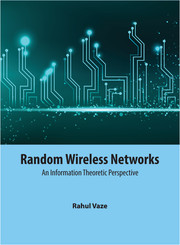Book contents
- Frontmatter
- Dedication
- Contents
- List of Figures
- Preface
- Acknowledgments
- Notation
- 1 Introduction
- 2 Transmission Capacity of ad hoc Networks
- 3 Multiple Antennas
- 4 Two-Way Networks
- 5 Performance Analysis of Cellular Networks
- 6 Delay Normalized Transmission Capacity
- 7 Percolation Theory
- 8 Percolation and Connectivity in Wireless Networks
- 9 Throughput Capacity
- Index
- Frontmatter
- Dedication
- Contents
- List of Figures
- Preface
- Acknowledgments
- Notation
- 1 Introduction
- 2 Transmission Capacity of ad hoc Networks
- 3 Multiple Antennas
- 4 Two-Way Networks
- 5 Performance Analysis of Cellular Networks
- 6 Delay Normalized Transmission Capacity
- 7 Percolation Theory
- 8 Percolation and Connectivity in Wireless Networks
- 9 Throughput Capacity
- Index
Summary
In addition to the traditional cellular wireless networks, in recent past, many other wireless networks have gained widespread popularity, such as sensor networks, military networks, and vehicular networks. In a sensor network, a large number of sensors are deployed in a geographical area for monitoring physical parameters (temperature, rainfall), intrusion detection, animal census, etc., while in a military network, heterogenous military hardware interconnects to form a network in a battlefield, and vehicular networks are being deployed today for traffic management, emergency evacuations, and efficient routing. For efficient scalability, these new wireless networks are envisaged to be self-configurable with no centralized control, sometimes referred to as ad hoc networks.
The decentralized mode of operation makes it easier to deploy these networks, however, that also presents with several challenges, such as creating large amount of interference, large overheads for finding optimal routes, complicated protocols for cooperation and coordination. Because of these challenges, finding the performance limits, both in terms of the amount of information that can be carried across the network and ensuring connectivity in the wireless network, is a very hard problem and has remained unsolved in its full generality.
From an information-theoretic point of view, where we are interested in finding the maximum amount of information that can be carried across the network, one of the major bottlenecks in wireless network is the characterization of interference. To make use of the spatial separation between nodes of the wireless network, multiple transmitters communicate at the same time, creating interference at other receivers. The arbitrary topology of the network further compounds the problem by directly affecting the signal interaction or interference profile. Thus, one of the several trade-offs in wireless networks is the extent of spatial reuse viz-a-viz the interference tolerance. Another important trade-off is the relation between the radio range (distance to which each node can transmit) of sensor nodes and the connectivity of the wireless network. Small radio range leads to isolated nodes, while larger radio ranges result in significant interference at the neighboring receivers affecting connectivity.
- Type
- Chapter
- Information
- Random Wireless NetworksAn Information Theoretic Perspective, pp. xi - xiiiPublisher: Cambridge University PressPrint publication year: 2015



